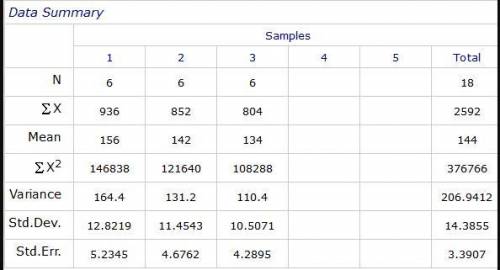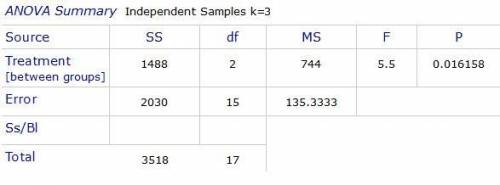a)1488
b) 744
c) 2030
d) 135.333
e) see attached table
f) There is sufficient evidence to reject the claim of equal means.
Step-by-step explanation:
a) Determine the value of total-group variability SS(tot):
SS(tot)=∑x^2(tot)-(x(tot))^2/N=376766-2592^2/18 ≅ 3518
Determine the value of the sum of squares between groups:
SS(bet) = ∑_(all groups) (∑x_i)^2/n_i -(∑x(tot))^2/N
=936^2/6+852^2/6+804^2/6-2592^2/6≅ 1488
b) d.f(BET) is the number of groups k decreased by 1.
d.f(BET) = k - 1= 3-1 = 2
MS(BET) is SS(BET) divided by d.f(BET):
MS(BET)=SS(BET)/ d.f(BET)
=1488/2
=744
c) The value of the sum of squares within groups (due to error) is then the value of the total-group variability decreased by the value of the sum of squares between groups (Note: using this calculation you then immediately obtain that the sum SS(tot) =SS(bet)+ SS(W) holds):
SS(W) = SS(tot) - SS(bet) = 3518 - 1488 = 2030
d) d.f.w is the total sample size decreased by the number of groups k.
d.f.w = N — k = 18 — 3 = 15
MSw is SSw divided by d.f.w:
MSw =SSw/d.f.w=2030/15=135.333
e) see attached table
f) The value of the test statistic F is then MS(BET) divided by MSw:
F=MS(BET)/MSw=744/135.3333≅5.5
The degrees of freedom are the same as those for between groups and within groups:
d.f.N=d.f(BET)=2
d.f.D=d.f.w=15
The P-value is the probability of obtaining the value of the test statistic, or a value more extreme. The P-value is the number (or interval) in the column title of Table 4 containing the F-value in the row dfn = 2 and dfd = 15:
0.01<P<0.025
If the P-value is less than the significance level, reject the null hypothesis.
P<0.05==> Reject H_o
There is sufficient evidence to reject the claim of equal means.

